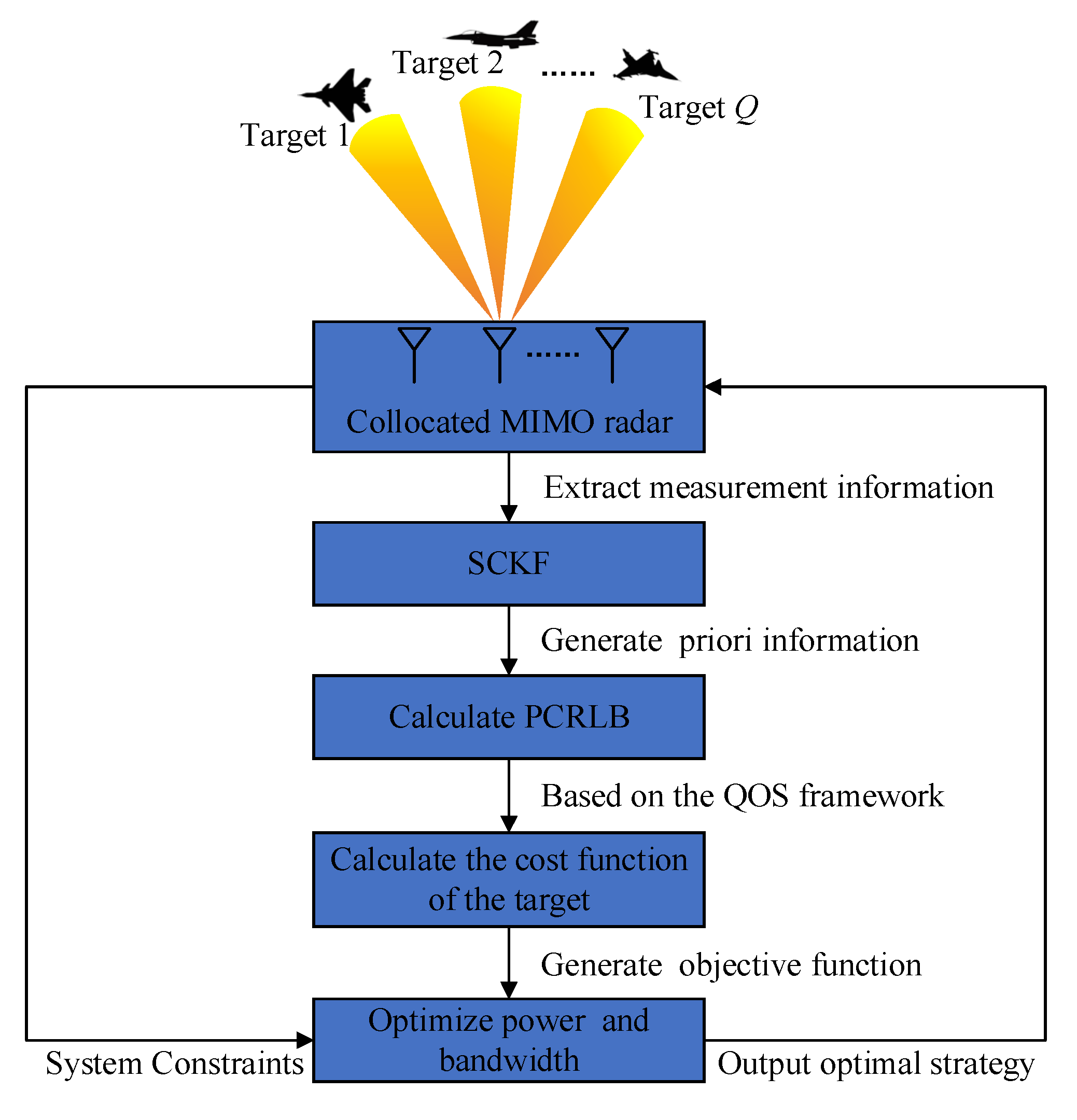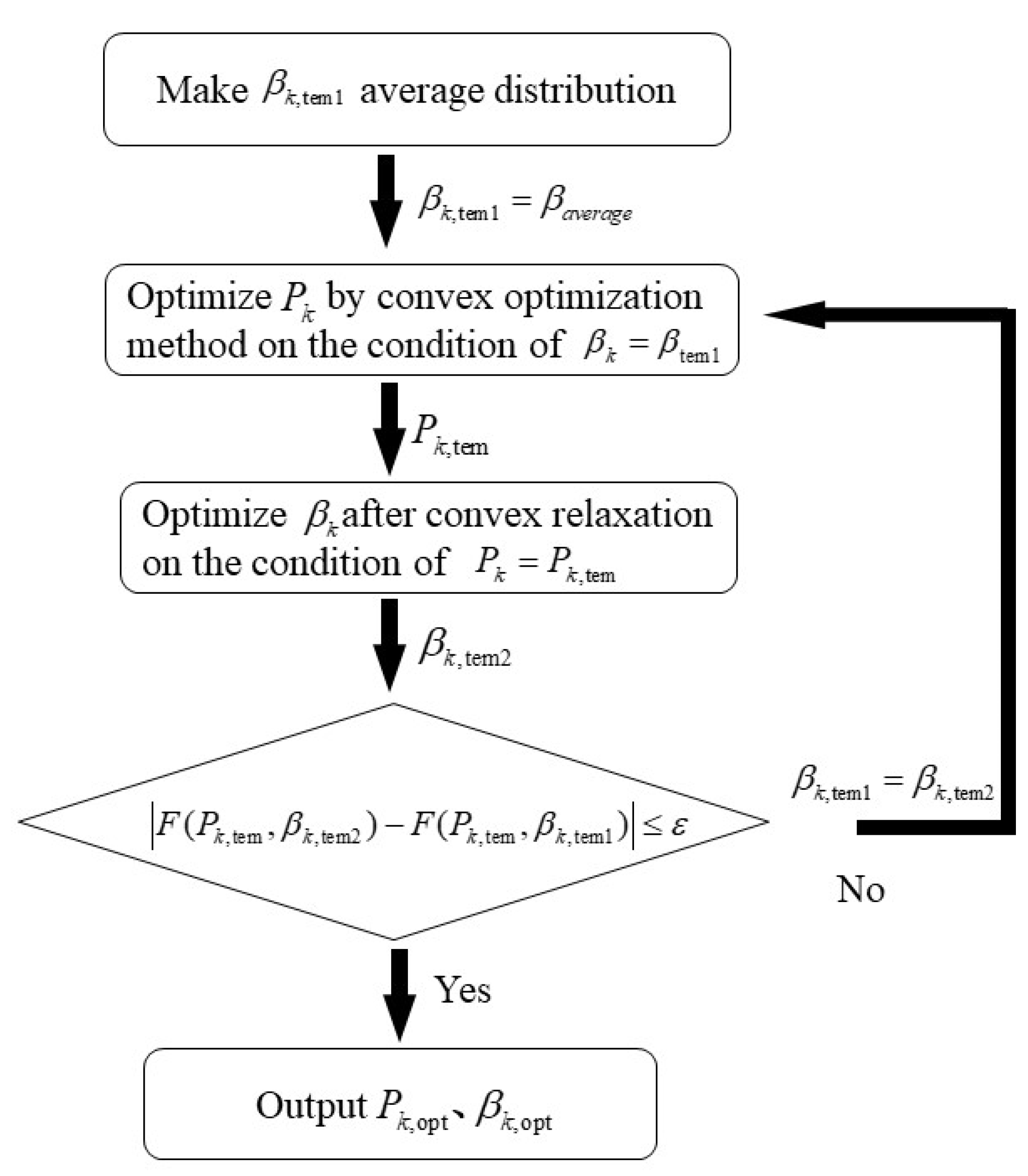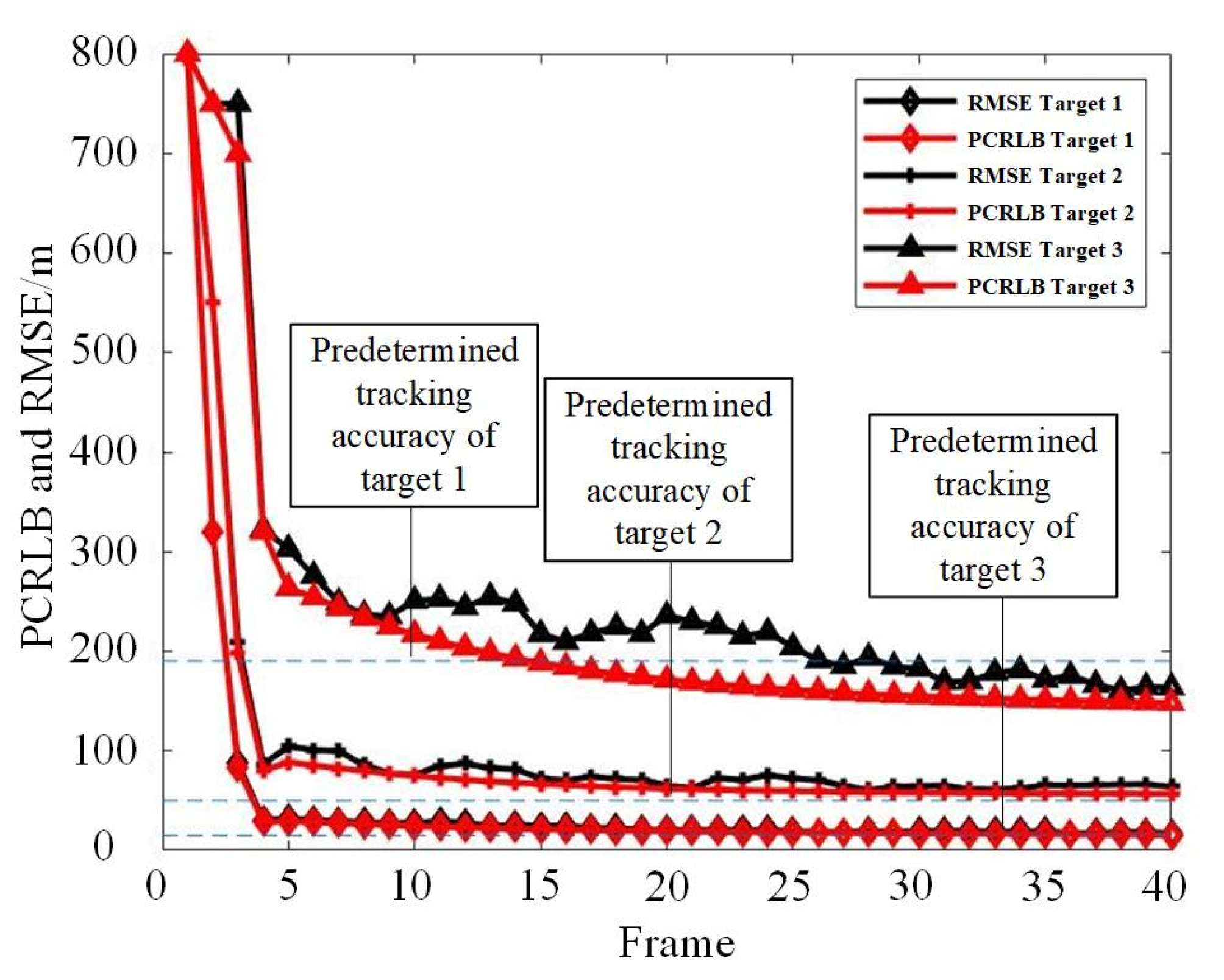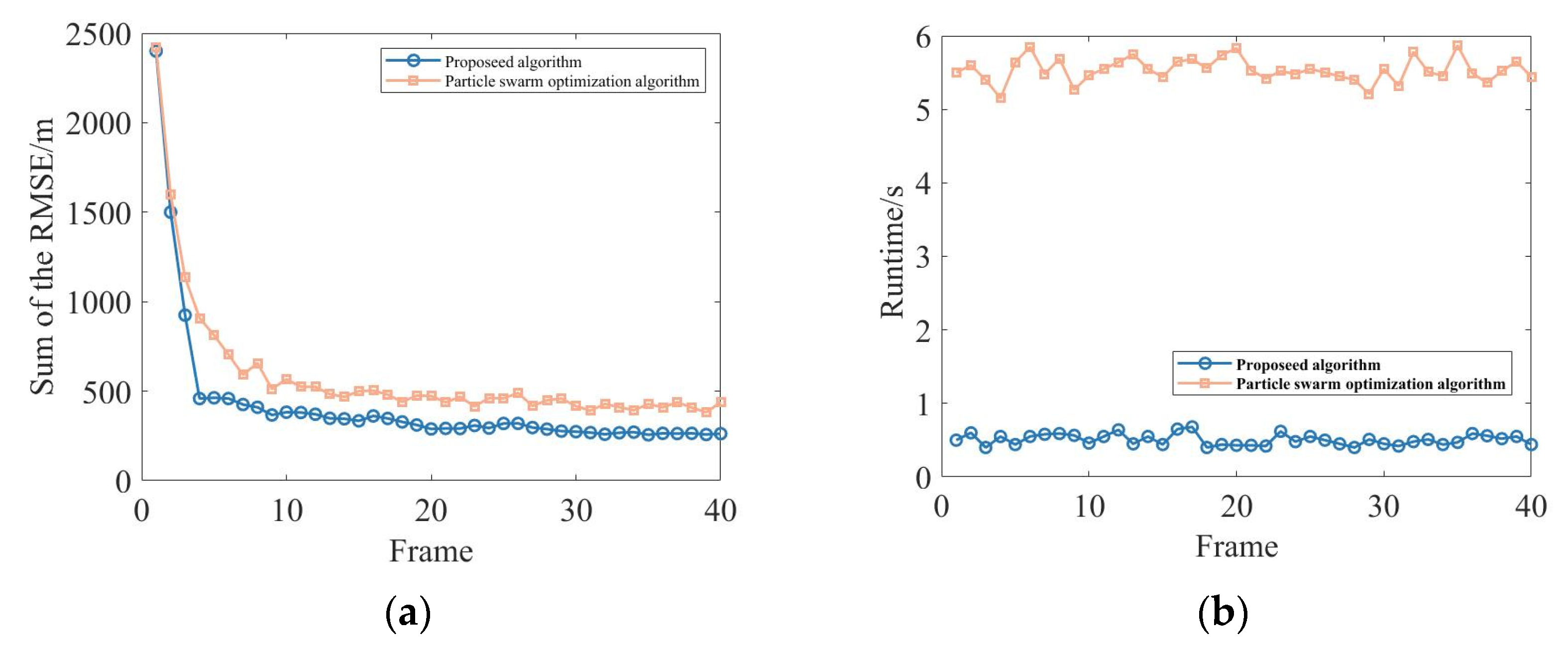Joint Power and Bandwidth Allocation in Collocated MIMO Radar Based on the Quality of Service Framework
Abstract
:1. Introduction
1.1. Background and Related Studies
1.2. Motivation and Main Contributions
- A joint optimization model based on the QoS framework is established in this paper. Based on the closed-loop structure of cognitive tracking that is shown in Figure 1, the objective function is improved using the QOS framework. The model overcomes the shortcomings of the min–max principle and has better performance with different threat targets.
- To deal with different threat targets, a target threat assessment model is proposed to evaluate the threat level. This paper provides a more reasonable target threat level given method, which is more suitable for the actual battlefield scenario.
- An algorithm with convex relaxation and cyclical minimization techniques is proposed. Compared with the particle swarm optimization algorithm, the proposed algorithm has a shorter operation time and higher precision.
- A closed-loop structure of cognitive tracking is developed. As is shown in Figure 1, the target state is updated via a square root cubature Kalman filter (SCKF) [24], and then the cost function is composed of the PCRLB based on the QOS framework. Finally, the radar resource allocation results are fed back to the radar.
2. System Model
- The radar was assumed to operate in the simultaneous multi-beam working mode, which can transmit multiple orthogonal wide beams and perform digital beam formation on the receiver side, and then extract measurement information;
- Each beam transmitted by the radar can only track one target, and the transmitted beam power and bandwidth can be controlled;
- There are Q targets in space, and each target is separated from the other.
2.1. Signal Model
2.2. Target Motion Model
2.3. Measurement Model
2.4. Derivation of PCRLB
3. Optimization Model
3.1. Target Threat Assessment Model
3.1.1. Target Distance
3.1.2. Radial Velocity
3.1.3. Target Type
3.1.4. Target Heading Angle
3.2. Objective Function
4. Solution Algorithm
| Algorithm 1: Pseudo code of the proposed algorithm |
| Initialization: Fix as average allocation, . |
| while |
| (1) Optimize by the convex optimization tools on the condition of , obtain the temporary optimization value . |
| (2) Convert the problem into a minimization problem of vector by the convex relaxation technique |
| (3) Optimize by the convex optimization tools on the condition of , obtain the temporary optimization value |
| end while |
| Output: |
5. Results
5.1. Same Target Threat Level
5.2. Different Target Threat Levels
5.3. Algorithm Comparison and Analysis
6. Conclusions
Author Contributions
Funding
Data Availability Statement
Conflicts of Interest
References
- Fishler, E.; Haimovich, A.; Blum, R.; Chizhik, D.; Valenzuela, R.A. MIMO radar: An idea whose time has come. In Proceedings of the IEEE Radar Conference, Philadelphia, PA, USA, 26–29 April 2004; pp. 71–78. [Google Scholar]
- Haimovich, A.M.; Blum, R.S.; Cimini, L.J. MIMO radar with widely separated antennas. IEEE Signal Process. Mag. 2007, 25, 116–129. [Google Scholar] [CrossRef]
- Cui, G.; Li, H.; Rangaswamy, M. MIMO radar waveform design with constant modulus and similarity constraints. IEEE Trans. Signal Process. 2014, 62, 343–353. [Google Scholar] [CrossRef]
- Chu, J. MIMO radar: Theory and application. IEEE Microw. Mag. 2020, 21, 66–67. [Google Scholar] [CrossRef]
- Fishler, E.; Haimovich, A.; Blum, R.S.; Cimini, L.J.; Chizhik, D.; Valenzuela, R.A. Spatial diversity in radars-models and detection performance. IEEE Trans. Signal Process. 2006, 54, 823–838. [Google Scholar] [CrossRef]
- Li, J.; Stoica, P. MIMO radar with colocated antennas. IEEE Signal Process. Mag. 2007, 24, 106–114. [Google Scholar] [CrossRef]
- Haykin, I. Cognitive radar—A way of the future. IEEE Signal Process. Mag. 2006, 23, 30–40. [Google Scholar] [CrossRef]
- Garcia, N.; Haimovich, A.; Coulon, M.; Lops, M. Resource allocation in MIMO radar with multiple targets for non-coherent location. IEEE Trans. Signal Process. 2014, 62, 2656–2666. [Google Scholar] [CrossRef] [Green Version]
- Shi, S.; Li, G.; Li, Z.; Zhu, H.; Gao, B. Joint power and bandwidth allocation for beam-hopping user downlinks in smart gateway multibeam satellite systems. Int. J. Distrib. Sens. Netw. 2017, 13, 1550147717709461. [Google Scholar] [CrossRef]
- Li, Z.; Xie, J.; Zhang, H.; Zhang, Z. Joint power and bandwidth allocation algorithm based on collocated MIMO radar. J. Syst. Eng. Electron. 2020, 42, 9. [Google Scholar]
- Zhang, H.; Zong, B.; Xie, J. Power and bandwidth allocation for multi-target tracking in collocated MIMO radar. IEEE Trans. Veh. Technol. 2020, 69, 9795–9806. [Google Scholar] [CrossRef]
- Yan, J.; Liu, H.; Jiu, B.; Chen, B.; Liu, Z.; Bao, Z. Simultaneous multibeam resource allocation scheme for multiple target tracking. IEEE Trans. Signal Process. 2015, 63, 3110–3122. [Google Scholar] [CrossRef]
- Rajkumar, R.; Lee, C.; Lehoczky, J.; Siewiorek, D. A resource allocation model for QoS management. In Proceedings of the 18th IEEE Real-Time Systems Symposium, Washington, DC, USA, 2–5 December 1997; pp. 298–307. [Google Scholar]
- Yuan, Y.; Yi, W.; Kirubarajan, T.; Kong, L. Scaled accuracy based power allocation for multi-target tracking with colocated MIMO radars. IEEE Trans. Signal Process. 2019, 158, 227–240. [Google Scholar] [CrossRef]
- Yi, W.; Yuan, Y.; Hoseinnezhad, R.; Kong, L. Resource scheduling for distributed multi-target tracking in netted colocated MIMO radar systems. IEEE Trans. Signal Process. 2020, 68, 1602–1617. [Google Scholar] [CrossRef]
- Shi, C.; Wang, Y.; Salous, S.; Zhou, J.; Yan, J. Joint transmit resource management and waveform selection strategy for target tracking in distributed phased array radar network. IEEE Trans. Aerosp. Electron. Syst. 2022, 58, 2762–2778. [Google Scholar] [CrossRef]
- Shi, C.; Wang, F.; Salous, S.; Zhou, J. Joint transmitter selection and resource management strategy based on low probability of intercept optimization for distributed radar networks. Radio Sci. 2018, 53, 1108–1134. [Google Scholar] [CrossRef] [Green Version]
- Shi, C.; Ding, L.; Wang, F.; Salous, S.; Zhou, J. Low probability of intercept-based collaborative power and bandwidth allocation strategy for multi-target tracking in distributed radar network system. IEEE Sens. J. 2020, 20, 6367–6377. [Google Scholar] [CrossRef]
- Shi, C.; Ding, L.; Wang, F.; Salous, S.; Zhou, J. Joint target assignment and resource optimization framework for multitarget tracking in phased array radar network. IEEE Syst. J. 2021, 15, 4379–4390. [Google Scholar] [CrossRef]
- Zhang, W.; Shi, C.; Zhou, J.; Lv, R. Joint aperture and transmit resource allocation strategy for multitarget localization in the phased array radar network. IEEE Trans. Aerosp. Electron. Syst. 2023, 59, 1551–1565. [Google Scholar]
- Li, Z.; Xie, J.; Zhang, H.; Ge, J.; Qi, C. A robust power allocation strategy based on benefit-cost ratio for multiple target guidance in the C-MIMO radar system under blanket jamming. EURASIP J. Adv. Signal Process. 2022, 1, 48. [Google Scholar] [CrossRef]
- Zhang, H.; Liu, W.; Zhang, Q.; Xie, J. Joint resource optimization for a distributed MIMO radar when tracking multiple targets in the presence of deception jamming. Signal Process. 2022, 200, 108641. [Google Scholar] [CrossRef]
- Ma, S.; Zhang, H.; Yang, G. Target threat level assessment based on cloud model under fuzzy and uncertain conditions in air combat simulation. Aerosp. Sci. Technol. 2017, 67, 49–53. [Google Scholar] [CrossRef]
- Zhang, H.; Xie, J.; Ge, J.; Lu, W.; Zong, B. Adaptive strong tracking square-root cubature Kalman filter for maneuvering aircraft tracking. IEEE Access 2018, 6, 10052–10061. [Google Scholar] [CrossRef]
- Yan, J.; Jiu, B.; Liu, H.; Chen, B.; Bao, Z. Prior knowledge-based simultaneous multibeam power allocation algorithm for cognitive multiple targets tracking in clutter. IEEE Trans. Signal Process. 2015, 63, 512–527. [Google Scholar] [CrossRef]
- Yan, J.; Liu, H.; Jiu, B.; Bao, Z. Power allocation algorithm for target tracking in unmodulated continuous wave radar network. IEEE sensors journal. IEEE Sens. J. 2014, 15, 1098–1108. [Google Scholar]
- Li, X.; Jilkov, V. Survey of maneuvering target tracking. Part I: Dynamic models. IEEE Trans. Aerosp. Electron. Syst. 2003, 39, 1333–1364. [Google Scholar]
- Xie, M.; Yi, W.; Kong, L.; Kirubarajan, T. Receive-beam resource allocation for multiple target tracking with distributed MIMO radars. IEEE Trans. Aerosp. Electron. Syst. 2018, 54, 2421–2436. [Google Scholar] [CrossRef]
- Yan, J.; Liu, H.; Pu, W.; Zhou, S.; Zheng, L.; Zheng, B. Joint beam selection and power allocation for multiple target tracking in netted colocated MIMO radar system. IEEE Trans. Signal Process. 2016, 64, 6417–6427. [Google Scholar] [CrossRef]
- Tichavsky, P.; Muravchik, C.H.; Nehorai, A. Posterior Cramer-Rao bounds for discrete-time nonlinear filtering. IEEE Trans. Signal Process. 1998, 46, 1386–1396. [Google Scholar] [CrossRef] [Green Version]
- Glass, J.D.; Smith, L.D. MIMO radar resource allocation using posterior Cramer-Rao lower bounds. In Proceedings of the IEEE Aerospace Conference, Big Sky, MT, USA, 5–12 March 2011; pp. 1–9. [Google Scholar]
- Qu, C.; He, Y. A method of threat assessment using multiple attribute decision making. In Proceedings of the 6th International Conference on Signal Processing, Beijing, China, 26–30 August 2002; pp. 1091–1095. [Google Scholar]
- Su, M.; Lai, S.; Lin, S.; You, L. A new approach to multi-aircraft air combat assignments. Swarm Evol. Comput. 2012, 6, 39–46. [Google Scholar] [CrossRef]









| Target Type | |
|---|---|
| Bomber Group | 0.8 |
| Fighter Group | 0.7 |
| Bomber | 0.6 |
| Unknown Type | 0.5 |
| Fighter | 0.4 |
| Unmanned Aerial Vehicle (UAV) | 0.3 |
| Jammer | 0.2 |
| Early Warning Aircraft | 0.1 |
| Target | Location (km) | Velocity (m/s) | Acceleration (m2/s) |
|---|---|---|---|
| Target 1 | (10, 40) | (−100, −10) | (0, −5) |
| Target 2 | (30, 50) | (100, 200) | (−10, 0) |
| Target 3 | (50, 80) | (−100, 0) | (−5, 2) |
Disclaimer/Publisher’s Note: The statements, opinions and data contained in all publications are solely those of the individual author(s) and contributor(s) and not of MDPI and/or the editor(s). MDPI and/or the editor(s) disclaim responsibility for any injury to people or property resulting from any ideas, methods, instructions or products referred to in the content. |
© 2023 by the authors. Licensee MDPI, Basel, Switzerland. This article is an open access article distributed under the terms and conditions of the Creative Commons Attribution (CC BY) license (https://creativecommons.org/licenses/by/4.0/).
Share and Cite
Huang, J.; Yang, Z.; Xie, J.; Zhang, H.; Li, Z. Joint Power and Bandwidth Allocation in Collocated MIMO Radar Based on the Quality of Service Framework. Electronics 2023, 12, 2567. https://doi.org/10.3390/electronics12122567
Huang J, Yang Z, Xie J, Zhang H, Li Z. Joint Power and Bandwidth Allocation in Collocated MIMO Radar Based on the Quality of Service Framework. Electronics. 2023; 12(12):2567. https://doi.org/10.3390/electronics12122567
Chicago/Turabian StyleHuang, Jieyu, Ziqing Yang, Junwei Xie, Haowei Zhang, and Zhengjie Li. 2023. "Joint Power and Bandwidth Allocation in Collocated MIMO Radar Based on the Quality of Service Framework" Electronics 12, no. 12: 2567. https://doi.org/10.3390/electronics12122567
APA StyleHuang, J., Yang, Z., Xie, J., Zhang, H., & Li, Z. (2023). Joint Power and Bandwidth Allocation in Collocated MIMO Radar Based on the Quality of Service Framework. Electronics, 12(12), 2567. https://doi.org/10.3390/electronics12122567






